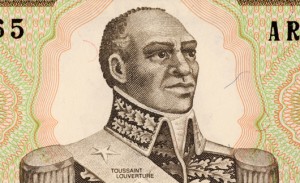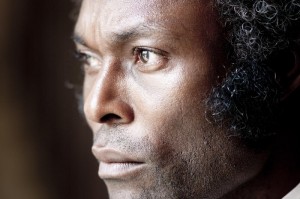By Ardain Isma
CSMS Magazine
 Most of us may not have been aware of it. A film depicting the life of Toussaint Louverture was released last year on French television France 2 featuring Jimmy Jean-Louis as the lead actor in the role of Toussaint Louverture. It was the first time Toussaint has been given such attention in a motion picture. France Zobda and Jean-Lou Monthieux from ELOA PROD directed the movie which was filmed in large part in Martinique. The east Caribbean island was considered an ideal place to create a mini replica of 18th century Saint Domingue.
Most of us may not have been aware of it. A film depicting the life of Toussaint Louverture was released last year on French television France 2 featuring Jimmy Jean-Louis as the lead actor in the role of Toussaint Louverture. It was the first time Toussaint has been given such attention in a motion picture. France Zobda and Jean-Lou Monthieux from ELOA PROD directed the movie which was filmed in large part in Martinique. The east Caribbean island was considered an ideal place to create a mini replica of 18th century Saint Domingue.
Toussaint Louverture was a huge success last February in Fort-De-France where it was premiered. According to RFO (Radio France d’Outre Mer), the movie received a standing ovation during its first presentation, and the public just could not get enough of it. The film went on to be selected in France au festival de Luchon and in Montreal Film Festival last May. Also, Toussaint Louverture won three prizes at the 2012 Pan African Film Festival in LA — Best Feature Narrative, an Audience Award for Narrative Feature and the Best Actor award for Jean-Louis’ portrayal of Toussaint.
The producers hope this film will trigger a resurgence on the interest in learning more about not only the life of Toussaint Louverture, but also about the historic achievements of Saint Domingue—the name of historical Haiti—and its legendary heroes.
 The success of this film brings with it the talented success of Jimmy Jean-Louis, one must say, who brilliantly played his role in his attempts to reincarnate the most powerful black man of the 18th century. This is a thrilling symbiosis that all Haitians should be proud of. At some point during the film, one gets the feel that Jimmy’s un-quivered patriotism has reached its zenith. He must have been very proud to play such a role. It was a clever move to hire a Haitian actor to lead the story—a BIG win for Jimmy.
The success of this film brings with it the talented success of Jimmy Jean-Louis, one must say, who brilliantly played his role in his attempts to reincarnate the most powerful black man of the 18th century. This is a thrilling symbiosis that all Haitians should be proud of. At some point during the film, one gets the feel that Jimmy’s un-quivered patriotism has reached its zenith. He must have been very proud to play such a role. It was a clever move to hire a Haitian actor to lead the story—a BIG win for Jimmy.
However, Jimmy was not the only Haitian actor auditioned for the montage. Jessica Géneus, a charming Haitian actress, also took part, although her role was rather an insignificant one, playing the role of one of the concubines of Georges Biassou, one of the first rebel leaders at the start of the Haitian revolution. Jessica was given the role of a mute or simply her role was bluntly muted, never allowed to utter a single word during her short appearance. One would believe Jessica could be as effective as any of the other actors.
Weeding out the fiction from the truth
 Although quite impressive as a motion picture and one that most Haitians should take pride in seeing their island past glory being recognized and honored, the story itself was presented in a very simplistic format. One might infer that the idea of simplifying or fictionalizing the story was to make it easier for the actors who may have not known much about the complicated events that took place in Saint Domingue from 1791 to 1804.
Although quite impressive as a motion picture and one that most Haitians should take pride in seeing their island past glory being recognized and honored, the story itself was presented in a very simplistic format. One might infer that the idea of simplifying or fictionalizing the story was to make it easier for the actors who may have not known much about the complicated events that took place in Saint Domingue from 1791 to 1804.
Right from the get-go, the producers made it clear that it was a work of fiction—an important disclaimer they must have hoped would shield them from the movie’s historical flaws. Thus, through Toussaint Louverture, it is fair to say that the world is being drawn into a genre of surrealistic epopee.
For instance, the story begins with Toussaint and his family being led by their captors through the snowy Jura Mountain on his way to Fort De Joux, where Toussaint eventually died in April of 1803. With prisoner Toussaint in the snowy mountain were his wife Suzanne and his sons Placide and Isaac. This assertion can’t be any further from the truth. Several historical accounts proved this was not the case, including Isaac’s own memoir published in 1818. Arriving in France, according to Isaac Louverture who was an eyewitness to this historical tragedy, Placide was taken to a detention center in Belle-Ile-en-Mer near Toulon, while Suzanne Louverture with her sons, Isaac and Saint Jean, remained inside the vessel Le Héros at the port of Brest. La traversée se fit rapidement; car au bout de vingt-cinq jours, les côtes de la Bretagne furent aperçues; et le vaissau le Héros mouilla à la rade de Brest…..[then] le brick la Nayade eut l’ordre de mener Placide Louverture à Belle-Ile-en-Mer. (Mémoires d’Isaac Toussaint (page 315) (The trip was rather quick, for in 25 days, the beaches of Bretagne was clearly visible on the horizon; and the vessel le Héros was anchored at the port of Brest….[then]the vessel la Nayade received the order to take Placide Louverture [to a prison] in Belle-Ile-en-Mer.) Meanwhile Toussaint and the rest of his family remained aboard le Héros. Five days later, une douzaine d’officiers de la gendarmerie vinrent chercher Toussaint Louverture (page 316) (A dozen officers from the French gendarmerie moved in and escorted Toussaint Louverture) out of the vessel under the blazing eyes of the family members, including Mademoiselle Chancy, Toussaint’s niece, who was inconsolably crying. Toussaint was only allowed to take with him his personal servant and secretary, Mars Plaisir.
Showing Toussaint being snatched from his relatives under the blows of rifle butts through an icy mountain is a great way to show the sadistic side of Napoleonic France. However, a scene where Toussaint Louverture is being formally arrested on board of a vessel near the port of Brest as his family watch in horror would have created the equal effect. But the latter form would have been better; it would have been consistent with the truth.
Also, in one dramatic scene, it was shown that Dessalines executed Biassou to prove his unequivocal desire to follow Toussaint. Also, that was not truth. Despite Biassou’s cruel ways at dealing with not only whites but also anyone who dared to challenge his authority, he was never captured, let alone killed in the island. Biassou never returned to the French as Toussaint did, even after it became clear that the Spanish government would not abolish slavery. Biassou went on to follow the Spaniards to Saint Augustine, Florida in 1796, which was then part of Spanish colony of Cuba. Biassou lived in the Salcedo House on Saint George Street and commanded a black militia out of Fort Matanza. Biassou died in 1801 and “buried at Tolomato Cemetery on Cardova Street.” (The Louverture Project)
The most important flaw in this historical account is the raw distinction being drawn between the different layers in Saint Domingue. Of course it is easy to understand the incompatible/impossible rapprochement between slaves and their masters. But the division between freed or colored people and the slaves was a rather complicated one, and to portray André Rigaud as the pivotal figure behind this vexing rift between mulattoes and blacks is a gross disrespect to history, despite Rigaud’s countless lies and treasons directed against Toussaint.
In the movie, Rigaud is presented as the protagonist behind the idea of La France for the whites, Africa for the slaves and Saint Domingue for the mulattoes. Not truth, for according to Haitian historian Thomas Madiou, himself a mulatto, Rigaud differed with Toussaint on the issue of independence proposed by Toussaint after the subsequent wars against the British and the Spaniards. Rigaud and his loyalists called the Rigaudins wholehearted believed in the French emancipation proclamation of February of 1794 which abolished slavery on all French overseas colonies and awarded French citizenship to everyone who lived there, including the slaves. Toussaint disagreed, saying that only an outright independence could guarantee a long lasting freedom for the newly freed slaves. This has prompted the miserable and regrettable civil war of 1800. Of course, history has proven that Toussaint was right.
It is fair to say that Rigaud was the ultimate leader of the mulattoes, and he was very effective in the fight against the British forces in the South, as Toussaint himself recognized. It is also fair to say that the idea of shipping all blacks to Africa was a popular frame of thought among many mulattoes in colonial Haiti. Noticeably pushing this idea were the mulatto leaders from Jérémie, Saint Marc, Arcahaie and Môle Saint Nicolas, bastions of opportunist mulattoes headed by Jean-Baptiste Lapointe, who despised both their mothers (blacks) for making them the way they looked and their fathers (whites) for rejecting them. La pointe was an important character in Marie Vieux Chauvet’s historical novel La Danse sur le Volcan (Dance on the volcano).
Here is how Rigaud replied to a La Pointe letter urging him to unite against [this] “monster” (Toussaint Louverture) before he turns [our country] into a superb Guinea. Rigaud answered by saying that he was very surprised by La Pointe letter and he went on to say this:
“Si les Africains pour la liberté desquels j’ai combatti deviennent ingrats au point de méconnaître mes services, je n’en serai pas moins fidèles à ma patrie, pas moins attaché aux sublimes principes qui m’ont dirigé, je trouverais au fond de mon coeur la douce consolation d’avoir embrassé une cause à laquelle la mienne est nécessairement liée, et qui aurait été aussi la vôtre, si vous aviez connu vos vrai interest!…….” (Thomas Madiou: Histoire d’Haiti Tome I, page 365)
“If the Africans for whom their freedom I have fought will [someday] become thankless wretches to the point of misjudging my services, I would not be less faithful to my country, not less loyal to the highest level of principles that have been guiding me. Deep in my heart I will find the sweet consolation for having to embrace a cause in which mine is intrinsically linked, and which should have also been yours, if you understood your true interests!……”
One can see that Rigaud clearly disapproved and rejected La Pointe overture against Toussaint, even if his attitude toward the “Africans” could be described as dubious at best.
Finally, the movie deserves great admiration, for it was made not only to resurrect a long forgotten glory, but also to embellish an awesome past of the African Diaspora commandeered by none other than the historical Haitian heroes embodied in the romantic patriotism guided by Toussaint Louverture.
Note: Dr. Ardain Isma teaches Cross-Cultural Studies and Principles and Issues with Second Language Acquisition at University of North Florida (UNF). He is also a novelist and chief editor for CSMS Magazine. He may be reached at publisher@csmsmagazine.org


The best article I have read so far in a week.
Dear representative,
Please advise where the movie is available to view or buy.
I do not have this information.
Thanks,
Regards,
Patrick
Movie is available on Youtube. Just search for Toussaint Louverture recent movie.